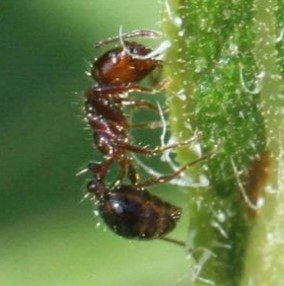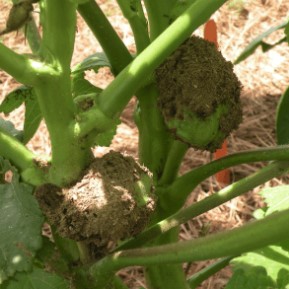For those that live in the South, they are more than likely aware of fire ants and the annoyance they cause to many vegetable gardeners and farmers (Figure 1). Besides being a nuisance in recreational areas and crop fields, fire ants are known to be pests in many crops. These crops include okra, potatoes, peanuts, sunflowers, hemp, and many others. Plants are especially vulnerable when they are small. Fire ants can also be pests in container vegetable production in greenhouses and other places. Although fire ants have an important ecological role in the environment and their cost versus benefit is debated fiercely, there is no doubt that controlling them in vegetable crops is important.

Figure 1. Red imported fire ant.

Figure 2. Fire ants on okra.
Why Control?
Controlling fire ants is sometimes difficult because their subterranean living makes it harder to detect them. Because it is harder to detect them, it could lead to more stinging incidents, which could be dangerous for a person with an allergy to the stings. Fire ants are not only potentially harmful to humans, but also to the vegetables themselves. They tend to protect aphids and other honeydew producers on vegetables, which often worsen their effects on the plants. Fire ants are also fiercely territorial predators that interfere with the natural enemies of many crop pests. Fire ants can also damage the crops themselves and contaminate the produce (Figure 2).
Cultural Control Tactics
Unfortunately, there are few cultural control options for long-term fire ant management in vegetable production systems. However, there are a few things producers can do to increase the effectiveness of other control measures.
- Control fire ant mounds around or outside the vegetable production area to prevent them from getting into the garden.
- Manage excessive plant residue on soil. This will help increase detection of foraging ants, gives ants fewer places to hide, and make it easier to scatter bait insecticides on open ground.
Insecticidal Approaches
The best time to apply broadcast baits is from April 15 to October 15. Mound treatments may be done year-round on warm, sunny days above 65 oF when the fire ants are active. They prefer temperatures between 70 and 95 oF. For mound treatments, apply products close or on the mound after checking foraging ants. The foraging workers are attracted to an oil-based carrier in the bait granule.
Choices for fire ant baits for vegetable farming or gardening are extremely limited and can be cost-prohibitive on large scale. There are only a few fire ant baits labelled for use in vegetable gardening. Most of these have spinosad, a microbial derivative, as the active ingredient. Always read the actual product label and check the crop listing before using. Organic products must carry the Organic Materials Review Institute (OMRI) label on front of the packing. Certified organic vegetable producers should contact their certifying agency before using the products listed below and keep accurate records. Spinisad-based bait products include
- Southern Ag PayBack Fire Ant Bait
- Fertilome Come and Get it
- Green Light with Conserve
D-limonene (orange oil) based products are available for individual mound treatment (e.g. Orange Guard).
Home Remedies
There are many home remedy options that are touted on social media platforms. Some of the most common include
- grits
- club soda
- soapy water
- wood ashes
- mixing mounds together
- vinegar and water solution
- baking soda
- molasses
All of these options have been scientifically proven to be ineffective at fire ant colony control and should be avoided. Monterey Ant Control granules (OMRI approved) with iron phosphate and spinosad can control over 15 different species of ants, but not fire ants. Iron phosphate is effective in controlling snails and slugs in garden. In lawns and other areas, follow the two-step fire ants management approach consisting of broadcasting a bait once or twice and year and treatment of individual mounds.
Source : aces.edu